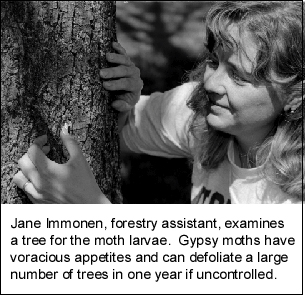The University Record, November 9, 1998
North Campus gypsy moth infestation under control
By Rebecca A. Doyle
 Residents of and visitors to the University’s North Campus area can breathe a little easier. Last fall, concern over defoliation of trees on one of the U-M’s beauty spots had phones ringing at the Grounds and Waste Management offices. Forester Marvin Pettway began a campaign early this past spring to control the gypsy moth infestation that threatened the area.
Residents of and visitors to the University’s North Campus area can breathe a little easier. Last fall, concern over defoliation of trees on one of the U-M’s beauty spots had phones ringing at the Grounds and Waste Management offices. Forester Marvin Pettway began a campaign early this past spring to control the gypsy moth infestation that threatened the area.
“It’s going very well,” Pettway said last week. “The Bt (Bacillus thuringiensis) treatments this spring were very effective.” It was not the goal of the program to completely eradicate the pesky larvae, but to gain control, he says, and the bacterial warfare has successfully controlled 80 percent of the population.
Bt is a bacteria that paralyzes the digestive system of the larvae, causing its death without affecting other wildlife in the area.
In addition to the fight mounted by Pettway and Jane Immonen, forestry assistant, the Gypsy moths had a natural battle to fight—a fungus named Entomophaga maimaiga. The fungus kills the larvae by deteriorating the exoskeleton.
 Traps set in the affected areas in August showed the “numbers were down dramatically,” Pettway says, after treatment near the School of Music, the wooded areas on Beal Avenue near Hayward, and the areas across from the Dow Building between Hubbard and Hayward streets.
Traps set in the affected areas in August showed the “numbers were down dramatically,” Pettway says, after treatment near the School of Music, the wooded areas on Beal Avenue near Hayward, and the areas across from the Dow Building between Hubbard and Hayward streets.
Neighbors in the North Campus area had expressed concern that even after the City of Ann Arbor treated its property, U-M trees might be affected if the campus infestations were not.
Pettway said the University will continue to monitor the area for outbreaks of gypsy moth larvae and take appropriate action, continuing spot treatments when necessary.
You can always drop us a line: [email protected].

